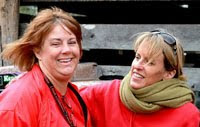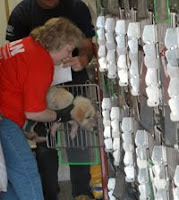BUT FIRST: STOP THE PRESSES!
My final blog entry was all written (see below), but then I heard from Julie Rathbun, the UAN volunteer at the Mississippi deployment who arranged with HSUS for the Animal Rescue Foundation (ARF) in her home city of Mobile, Alabama to take custody of two expectant mothers. Julie then drove both dogs to Mobile.
As previously reported, Mama Blondie had to be euthanized because of her medical condition. A few minutes ago, I heard from Julie about the other expectant mother, who has been named Harmony.
Julie reports, “Harmony has given birth to seven seemingly healthy puppies, along with three stillbirths. Her foster mom began giving her holistic care upon her arrival, as well as veterinary care. Harmony is regaining some strength and is nursing the puppies.”

And now for the highlight of this blog post – two photos of Mama Harmony and her babies!
Great going, Mama Harmony, and great going, Julie!!! Julie, you gave Harmony her new life! What a feeling that must be after the misery she was living in until we rescued her. Good thing we don’t deal in “what ifs” – my heart would break if I thought about what might have happened to these dogs and puppies if there has been no rescue in Kemper County, Mississippi.
 Thank you, too, to Animal Rescue Foundation in Mobile, Alabama, and especially Michelle Turner, its President, for agreeing to take responsibility for two expectant mothers who had been living lives of abuse and neglect, and thank you to HSUS, MARL and (Kemper County) Sheriff Moore for making the wheels of motion move fast enough for this to happen in one day!
Thank you, too, to Animal Rescue Foundation in Mobile, Alabama, and especially Michelle Turner, its President, for agreeing to take responsibility for two expectant mothers who had been living lives of abuse and neglect, and thank you to HSUS, MARL and (Kemper County) Sheriff Moore for making the wheels of motion move fast enough for this to happen in one day!Now, here’s the final blog looking back at my seven days with UAN in Mississippi:
For seven days this month, I was privileged to serve in the newly created position of "Volunteer Communications Assistant" at the UAN deployment in Mississippi. UAN created these positions at just the same time the Mississippi deployment was announced, and since I volunteered for Mississippi, I became the test pilot for this new approach in reporting from the deployment site.
The responsibilities of the Volunteer Communications Assistant are to spend about half of each day writing a daily blog and taking lots of photographs. Previously, this work was done by the staff person or volunteer in charge of the deployment, but given the hectic workload of those folks, there were hardly enough hours in the day for them to do the communications work as well.
It’s been so rewarding to write the daily blog and take photographs, calling attention to the work that UAN does and highlighting the wonderful dogs who lived in such desperate circumstances and the equally wonderful volunteers who are dedicated to giving these dogs a bright future.
In this, my final posting for the Mississippi deployment, I’m focusing on a few highlights.
 First, many thanks to Sheriff James Moore (at right) for making this rescue happen. But for him, the dogs would still be suffering, and before long, if not already, more of them would be dead. The hoarder had been in business for years, and many people knew about her, but it took Sheriff Moore, who became sheriff about 2-1/2 years ago, to build the case against her over time. He was the one who served the warrant on her and, in preparation for that day, called in the Mississippi Animal Rescue League, which in turn brought in HSUS, which in turn brought in UAN to participate in the rescue of the animals and to manage the shelter.
First, many thanks to Sheriff James Moore (at right) for making this rescue happen. But for him, the dogs would still be suffering, and before long, if not already, more of them would be dead. The hoarder had been in business for years, and many people knew about her, but it took Sheriff Moore, who became sheriff about 2-1/2 years ago, to build the case against her over time. He was the one who served the warrant on her and, in preparation for that day, called in the Mississippi Animal Rescue League, which in turn brought in HSUS, which in turn brought in UAN to participate in the rescue of the animals and to manage the shelter. As is true in all UAN deployments, another highlight was the stellar working relationships among UAN volunteers, and also with folks affiliated with the other animal organizations. We all went to Mississippi because we share a passion for the welfare of animals, not to make new friends, and yet, as is typical in UAN deployments, we did make new friends. The UAN volunteers in Mississippi were a diverse group.
As is true in all UAN deployments, another highlight was the stellar working relationships among UAN volunteers, and also with folks affiliated with the other animal organizations. We all went to Mississippi because we share a passion for the welfare of animals, not to make new friends, and yet, as is typical in UAN deployments, we did make new friends. The UAN volunteers in Mississippi were a diverse group. Jerry is an entrepreneur who owns two radio stations. Inga is a former environmental attorney turned animal shelter manager. Angela is a boat dealer. Julie volunteers at the sheriff’s office tracking Sudafed purchases. And so on and so forth. With this diversity, we each brought something different to the deployment, and even if we had nothing else in common with particular volunteers, our passion for the welfare of the dogs created a special bond. I hope that I have the opportunity to work again with all the volunteers who served in Mississippi.
Jerry is an entrepreneur who owns two radio stations. Inga is a former environmental attorney turned animal shelter manager. Angela is a boat dealer. Julie volunteers at the sheriff’s office tracking Sudafed purchases. And so on and so forth. With this diversity, we each brought something different to the deployment, and even if we had nothing else in common with particular volunteers, our passion for the welfare of the dogs created a special bond. I hope that I have the opportunity to work again with all the volunteers who served in Mississippi.I suppose the opposite of highlights are lowlights, and we had one of those – the emergency shelter was a former meat packing plant; the owner had cleaned it but left the equipment in place. With my urban upbringing, I didn’t recognize most of the equipment, but volunteers who had been raised on farms or who had farmers in their families pointed out how certain equipment was used, and it made my stomach turn. As Janell Matthies put it, though, we changed the karma of the place by converting it into a life-sustaining shelter.
 Of course, I’ve saved the top highlight for last: the dogs. The dogs in this deployment arrived at the shelter in need of medical attention, and we had two vet rooms going. Keeping in mind that seven dogs were found dead on the hoarder’s property on the day of the rescue, it was no surprise that some of the dogs were in very serious condition. Some had what appeared to be sarcoptic mange. Most were scratching almost incessantly. Most had scars from lacerations; some had open lacerations or sores. Some had big patches of no hair or had very little hair. Some were very skinny, even emaciated.
Of course, I’ve saved the top highlight for last: the dogs. The dogs in this deployment arrived at the shelter in need of medical attention, and we had two vet rooms going. Keeping in mind that seven dogs were found dead on the hoarder’s property on the day of the rescue, it was no surprise that some of the dogs were in very serious condition. Some had what appeared to be sarcoptic mange. Most were scratching almost incessantly. Most had scars from lacerations; some had open lacerations or sores. Some had big patches of no hair or had very little hair. Some were very skinny, even emaciated. The socialization time we spent with the dogs was the most rewarding, as we tried to find ways to show these dogs that life can be good and that people can be good. In criminal seizures in particular, where the animals have been abused, socialization is so important for the well-being of the dogs. The emotionally neediest dogs, such as Stevie and Hope, tugged the strongest at our heart strings, but our hearts went out to all the dogs who had been living lives of abuse. When I left for home, saying goodbye to the dogs was the hardest part, but it was also the best part because I know that their futures are now hopeful.
The socialization time we spent with the dogs was the most rewarding, as we tried to find ways to show these dogs that life can be good and that people can be good. In criminal seizures in particular, where the animals have been abused, socialization is so important for the well-being of the dogs. The emotionally neediest dogs, such as Stevie and Hope, tugged the strongest at our heart strings, but our hearts went out to all the dogs who had been living lives of abuse. When I left for home, saying goodbye to the dogs was the hardest part, but it was also the best part because I know that their futures are now hopeful.During the deployment and since arriving home, I’ve read the comments on the blog and UAN’s Facebook page. Many of the people who read this blog are UAN volunteers, and I know you’re all nodding when I say that UAN is a terrific organization, and I’m proud to be a UAN volunteer. UAN shelters are so well run and always with the proper care of animals as the top priority. Any concerns expressed by volunteers are addressed right way, with action taken as needed or responses given to our questions. The staff shows respect for the volunteers. We feel valued.
Most of all, when animals come into UAN’s care, they go from desperate lives to hopeful futures. Thank you, everyone who is part of UAN. Until the next time we meet . . . .











































